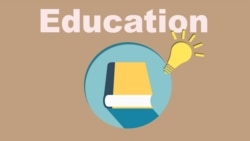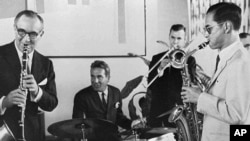April 30 is International Jazz Day.
In countries around the world, musicians, educators, students, and music lovers will take part in celebrations. These activities tell about the history of jazz and show new, creative directions that the music is taking.
In our Education Report today, we will explore the growth and development of jazz education in one part of the world: Asia.
We will discover how educators and students in Thailand, Malaysia, and China are putting their own mark on jazz music and jazz education.
What is Jazz?
Jazz is a form of American music that combines African rhythmic ideas with European harmony. It has roots in the folk music of the African diaspora – Africans who left (or were forced to leave) the continent. Improvisation and personal expression are important parts of the music.
In the 20th century, jazz changed from a folk music to a high art form. The number of jazz styles increased as many musicians brought their ideas to the music.
For much of the 20th century, American colleges and universities did not offer classes or training in jazz music. But ideas toward the music started to change in the 1960s and 1970s, according to the Thelonious Monk Institute, a non-profit group. Jazz education programs became more common in the United States in the 1980s and 1990s.
Thailand as a regional education hub
Now, jazz education is growing in some Asian countries.
Thailand, for example, is becoming a regional jazz education center.
"Thailand really is a mecca for jazz in Southeast Asia," said Jerome Quah, a Malaysian musician and educator.
Denny Euprasert is the Dean of Rangsit University (RSU) Conservatory of Music and director of the RSU Jazz Orchestra.
Euprasert says that when he was a boy, one of his first influences was the former King of Thailand, Bhumibol Adulyadej. The king was a saxophone player and composer. He would often play jazz with American musicians.
Euprasert heard the king's music and fell in love with it.
"Many people decided to study music because of the King of Thailand... Maybe that is why jazz is popular in Thailand," Euprasert explains.
"He [KING BHUMIBOL ADULYADEJ] would have music day for a university and he would just go there and play. I think that really inspired a lot of people…In many of his speeches, he would say that music is very important, and we should teach music the right way, and music can do good to people. As a person, you should have art and music in yourself."
Euprasert moved to the United States for many years. He received master and doctoral degrees at the University of North Texas and the University of Northern Colorado, respectively.
He returned to Thailand and started a jazz education workshop. Gene Aitken, a jazz educator and adviser of Euprasert, helped develop the program.
The workshop was launched about 10 years ago. The teachers were all Thai nationals; about 100 students attended a class that lasted two-to-three days.
Currently, about 300 high school and college students take part in the Thailand jazz workshop each year. Students come from Thailand, Vietnam, Singapore, Hong Kong, and Indonesia, Euprasert says. Foreign teachers – mainly from the United States – join Thai teachers to instruct students. "It keeps growing each year," he notes.
Currently, three universities in Thailand offer jazz degree programs. Euprasert adds that when he listens to musicians performing, he can tell which university they went to.
Jerome Quah, in Malaysia, attended workshops and had private lessons in Thailand. He adds that many Malaysian students travel to Thailand for training and to study at the universities there.
Quah says that Malaysia has seen growth in the popularity of jazz – although not the same level of growth as in Thailand. He notes that the state government provides support to two large jazz ensembles that he directs. In addition, Quah adds that a jazz appreciation society in Penang is undergoing government approval.
"I don't have the statistics," he said, "but I think it is becoming more popular here. The numbers [of jazz groups] keep growing."
China
Jazz education is growing in other Asian countries – China, for one.
Terence Hsieh is a Beijing-based trombone player and music educator. He says that the China's development and entry into the world economy have opened up many possibilities for students.
Parents send their children to special music schools, or sometimes international schools, for training in jazz. For more serious studies, Chinese students often travel overseas; the United States and the Netherlands are two top stops, Hsieh says.
Kevin Sun, a Brooklyn-based saxophonist, spent time in Beijing. He notes that not all Chinese musicians go overseas to study jazz. Some, he explains, are almost entirely self-taught and have developed very strong skills on their instruments.
Because jazz is relatively new to many Chinese, Hsieh explains, people often go to performances without expectations about what they will hear. This lack of expectations on the part of the crowd gives musicians artistic and creative freedom. The creative energy in Beijing, he adds, compares well to other cities that have a much larger jazz scene, such as New York City.
What do students find compelling about the music?
Hsieh says that his students enjoy jazz improvisation because it allows them to express themselves in artistic ways by using a musical language. Traditional Chinese arts, except for perhaps calligraphy, do not often rely on improvisation, Hsieh explains.
Jerome Quah, in Malaysia, says the idea of improvisation was what first got him interested in jazz.
He adds that Malaysian students like the freedom that jazz improvisation gives them. Students, he explains, like being able to play things that are not written down, as in classical music.
Denny Euprasert, in Thailand, says that his students like jazz because it is democratic. It is democratic, he explains, in the sense that each player in a small group gets a chance to play a supporting part and a leading role.
He adds that jazz education can create personal connections – even across language barriers. At a recent jazz camp, he said, students from across Southeast Asia met each other for the first time. Even though the students did not speak the same language, they were able to connect through their shared interest in the music.
"They became friends...Now, they keep in touch," Euprasert said. "I felt really happy to see that happen."
I'm John Russell.
John Russell wrote this story for VOA Learning English. George Grow was the editor.
We want to hear from you. Write to us in the Comments Section. ________________________________________________________________
Words in This Story
rhythmic – adj. having a regular repeated pattern of sounds
harmony – n. the combination of different musical notes played or sung at the same time to produce a pleasing sound
diaspora – n. a group of people who live outside the area in which they had lived for a long time or in which their ancestors lived — usually singular
improvisation – n. to speak or perform without preparation; to make or create (something) by using whatever is available
a mecca for -- idiomatic expression – a place that attracts many people
appreciation – n. an understanding or recognition
calligraphy – n. the art of making beautiful handwriting








